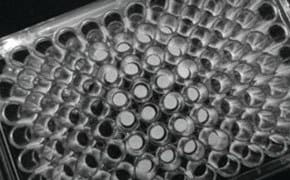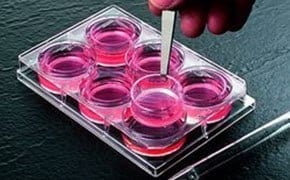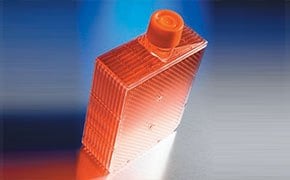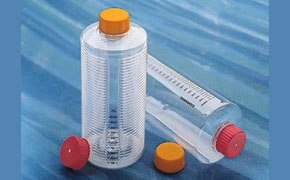Cell Culture Supplies
We offer a variety of cell culture supplies that specifically support the needs of researchers working with cell culture applications such as 3D cell proliferation, cell and tissue culture, cell preservation and storage, cell visualization, scale-up cell culture, and stem cell and tissue engineering.
Products
Cell culture flasks, plates, and dishes
Cell culture flasks, plates, and dishes are specifically designed for the growth and propagation of microbial, insect, or mammalian cells. We offer glass and plastic culture flasks for shaker cultures, tissue culture flasks for adherent and suspension cells, bioreactor flasks for monoclonal antibody (mAb) and protein production, petri dishes and culture dishes for microbiology and microscopy of living and fixed cells, disposable and reusable spinner flasks for suspension cell cultures, and cell culture plates for growth optimization and treatment from leading suppliers including Millicell®, Corning®, Brand®, Eppendorf®, Nunc®, Nalgene®, TPP®, Pyrex®, Wheaton®, and Greiner Bio-One.
Permeable supports and inserts
Cell culture permeable supports and inserts feature membranes that allow easy access to both the apical and basolateral sides of cells, producing a cell culture environment that more closely resembles an in vivo state.
- Millicell® inserts are designed to support cell growth and differentiation of epithelial and endothelial cell lines. Millicell® standing inserts promote excellent cell growth for cell studies. Millicell® hanging inserts enable easy removal for media feeding, changes, and monolayer analysis and can be used for co-culturing and permeability assays.
- Corning® Transwell inserts and plates feature membranes that are transparent when wet.
- Corning® Netwell® inserts have polyester mesh bottoms attached to a polystyrene ring or housing for culturing small organs, tissue slices, or explants
- Corning® Snapwell™ supports are modified Transwell inserts for transport and electrophysiological studies.
- BRAND® inserts feature excellent optical properties and include a standard model for co-culture, secretion studies, and chemotaxis tests, and a specialized model for automated in vitro preparation of human tissues.
Extracellular matrices for 3D cell culture
We carry a broad portfolio of three-dimensional cell culture systems including MaxGel™ human Extracellular Matrix (ECM), HydroMatrix™ synthetic peptide, and mouse ECM, to support stem cell and other cell cultures. These products provide three-dimensional environments in which cells are better able to mimic their in vivo counterparts.
- HydroMatrix™ is a synthetic peptide nanofiber scaffold that self-assembles and promotes cell growth and migration and has been shown to support the proliferation of many cell types including neural stem cells, neurons, glia, astrocytes, fibroblasts, and keratinocytes.
- MaxGel™ human ECM contains extracellular matrix components including collagens, laminin, fibronectin, tenascin, elastin, proteoglycans, and glycosaminoglycans. MaxGel™ ECM promotes cell growth and migration and has been shown to support the proliferation of many cell types, including neural stem cells, neurons, glia, astrocytes, fibroblasts, hepatocytes and keratinocytes.
- The HyStem® stem cell culture platform offers control over growth factor incorporation, attachment factor incorporation, ECM protein incorporation, and rigidity of the hydrogel. The HyStem® hydrogel scaffold closely mimics the rich, natural extracellular matrix environment, complete with hyaluronic acid and collagen fibrils, while offering the flexibility to customize with appropriate growth factors, attachment factors, and proteins.
- TrueGel3D preserves viability of your cells and replicate native cellular environments similar to those of tissues. This technology provides mechanical and biochemical cues to investigate both morphological and physiological properties of cells in the 3D environment.
Serological pipets
Serological pipets are commonly used in serology and cell culture to measure and dispense milliliter amounts of liquid. Available in glass or plastic, they typically have graduations for accurately measuring meniscus levels and are available sterile for aseptic cell culturing procedures. Cotton plug options are available to prevent overfilling and contamination. Large tip pipets are available for pipetting viscous liquids and suspensions.
Cell lifters and spreaders
Cell lifters are long-handled devices with angled heads used to harvest cells from cell culture flasks and dishes and are available in varying lengths and designs. Cell spreaders are designed for spreading cultures and media across the surface of agar plates.
Microfluidic devices for cell culture
Microfluidic devices for cell culture, including 3D chips and organ-on-a-chip technologies, permit the study of small numbers of cells in a 3D environment. Their use allows implementation of chemical gradients, continuous flow of fresh media, high throughput testing, and direct coupling to analytical instruments. Because microfluidic devices require small volumes of culture media and small quantities of cells, these technologies decrease costs and enable studies to be conducted when the cell source is limited.
Related Resources
- Article: Corning®
Corning® brand glass and plastic labware, filtration membranes, cell culture supplies, and equipment for life sciences.
- User Guide: 2 Cell Culture Guide
Corning Life Sciences offers a full line of cell culture products that are manufactured under strict process controls guaranteeing consistent product performance. All Corning Life Sciences plastics manufacturing facilities are ISO 9002 registered. ISO registration is recognized worldwide as a standard of excellence for quality systems
- User Guide: Cell Culture Equipment
Sterile polystyrene, 245 mm square x 18 mm deep, with lid. Dish has many uses, including large-scale colony-counting and plaque-lifting, microbial assays, hybridizations. Dishes stack without slipping.
To continue reading please sign in or create an account.
Don't Have An Account?


